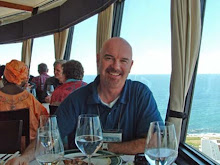



Wednesday afternoon was spent at Robben Island, the prison island just off Cape Town. Originally built as a leper colony and later used as a military station, it became a prison in the Apartheid era specifically for ‘Coloureds and Blacks.’ The ‘Whites’ were in another prison on the mainland. The racial divides were maintained here in the strangest ways: Coloureds got a better ration of food, as well as winter clothes; the Blacks got a simpler diet (and less of it), as well as only short pants and short-sleeve shirts (even for winter). Apparently long pants were handed out in the event of Red Cross visits. Men slept 80 to a dorm, with no mattresses or beds: only two quilted blankets each, one serving as a mat and the other as the blanket.
The quarry is where all prisoners worked five days a week. Most got lung and eye disease from the limestone dust and glare off the white rock. The prisoners worked out a system for talking here, since this was the only place in which they were watched from some distance: they would work in groups of five to eight and while the two end men actually worked the rock face, the others in between would fake their work. The noise would from the two workers would cover the conversation of the others.
One building was purpose-built for a single prisoner: Robert Sobukwe, the initiator of one of the first uprisings in the 1960’s, the burning of identity cards required only by ‘Coloureds and Blacks.’ This non-violent protest eventually sparked major clashes between protesters and police, and Sobukwe was imprisoned. The sentence was life solitary confinement, and he was refused any social interaction. Not even his guards were allowed to speak with him.
The main prison block is where Nelson Mandela was kept. This part of the tour was actually guided by former prisoners of Robben island. They, in fact, were major forcesin having the island declared a heritage site. Our guide was Mr. Sparks, who was arrested and imprisoned for inciting resistance to Apartheid, and was there for some eight years. He took us into his own dorm. Adjoining the dorm were the washroom facilities: two toilets, urinal trough, three showers, and five sinks for eighty men. Only cold water, even in winter.
Nelson Mandela had a solitary cell, about ten foot square. Only two mats, bucket for a toilet, and a table and chair. No heat. Our capacity for cruelty, domination, and humiliation seems to be boundless.
The catamaran ferry that takes you to Robben Island is called ‘Sikhululekile,’ which means “We are free now.”

No comments:
Post a Comment